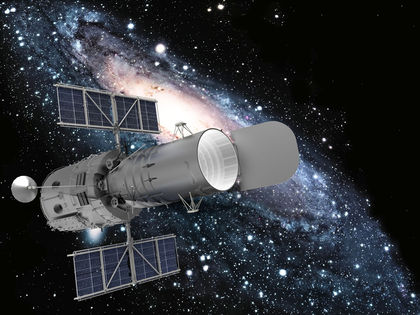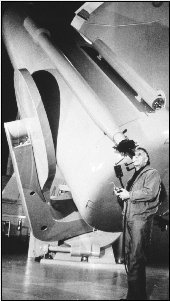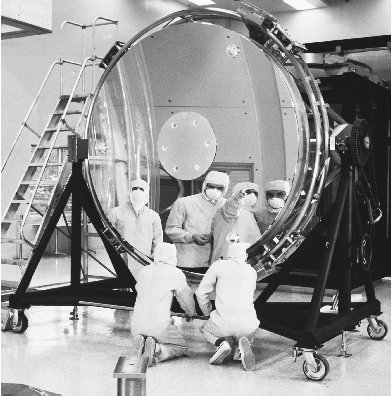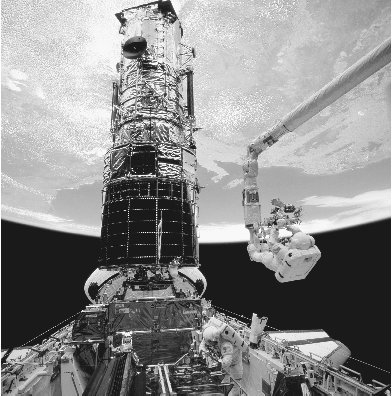Chapter 5
Hubble

In 1962, the National Academy of Sciences recommended the construction of a large optical telescope. More revolutionary than any of its predecessors, however, this one would be the first telescope rocketed into orbit to capture visible light waves. Astronomers explained to all potential sponsors that a telescope would be placed in orbit a few hundred miles above the earth's polluted and distorting atmosphere, with a primary mirror one-half that of Palomar's yet capable of producing photographs ten times sharper. Delayed many years by congressional debate and then by the 1986 explosion of the Challenger shuttle, the Hubble Space Telescope (HST), named to honor the preeminent astronomer Edwin Hubble, blasted into orbit in 1990 and immediately became the world's most publicized and most talked about telescope.
Escaping Earth's enveloping atmosphere gives an orbital telescope three distinct advantages over land-based instruments. First, an orbital telescope does not lose light coming from outer space that is filtered out by the gases, moisture, and dust swirling in the earth's atmosphere. Second, it is not affected by distortions created by rising heat from the earth's surface. And third, it only collects light produced by celestial objects, not from the electric light of metropolitan centers that mix with and degrade light from space. According to astronomers Daniel Fisher and Hilmar Duerbeck in their book Hubble: A New Window to the Universe , "Large telescopes on earth can get nowhere close to [Hubble's] resolution. Only a telescope in space can deliver stellar images of a few hundredths of an arcsecond." 22
American astronomers outlined five principal objectives for the HST: "Explore the Solar System, measure the age and size of the universe, search for our cosmic roots, chart the evolution of the universe, and unlock the mysteries of galaxies, stars, planets, and life itself." 23 Accomplishing such diverse objectives required a telescope that was capable of making, on the one hand, minute geological observations of small asteroids and comets little more than a few hundred feet across, while on the other hand studying and photographing super galaxy clusters billions of times larger than asteroids and comets in hopes of revealing the origins and destiny of the universe.
Construction
The HST is a telescope, but more than that, it is a satellite. A cylinder forty-three feet long, fourteen feet in diameter, and weighing 24,500 pounds, the HST is roughly the size of a school bus. Operating in the vacuum of space far from helping human hands, the satellite was constructed to accommodate some of the most technically complex astronomical instrumentation ever built.
To operate in space, the HST needs a power supply, communications equipment, computers, and a control system. Power is supplied by two 25-foot-long solar panels (384 square feet), each containing 48,760 individual photo cells. Together, the two panels are capable of generating 2,800 watts, roughly the equivalent of twenty-eight standard lightbulbs. The power generated by the panels is also used to charge six nickel-hydrogen batteries that provide power to the spacecraft for about twenty-five minutes per orbit while Hubble flies through the earth's shadow.
Designers of the Hubble Space Telescope had to take into account the conditions in which it was to operate. Hubble would be subject to the rigors of zero gravity and
Edwin Hubble
One of the great pioneers of modern astronomy, the American astronomer Edwin Powell Hubble was born in 1889 in Missouri. He began his adult life by earning a law degree and serving in World War I. However, after practicing law for one year, he decided to turn to astronomy. He completed a PhD dissertation, "The Photographic Investigation of Faint Nebulae," at the University of Chicago and then continued his work at Mt. Wilson Observatory in Pasadena, California, studying the faint patches of luminous "fog," or nebulae, in the night sky.
Using the largest telescope of its day, an eight-foot reflector, he studied Andromeda and a number of other nebulae and proved that they were other galaxies similar to our own Milky Way. He devised the classification scheme for galaxies that is still in use today, and he obtained extensive evidence that the laws of physics outside the galaxy are the same as on Earth—verifying the principle of the uniformity of nature. In 1929, using a one-hundred-inch telescope, he analyzed the speeds of recession of a number of galaxies and showed that the speed at which a galaxy moves away from the Milky Way is proportional to its distance. The explanation for this was apparent, yet revolutionary; he had proved that the universe is expanding, a principle now called Hubble's law.

temperature extremes that fluctuated several hundred degrees Fahrenheit during each trip around the earth. To protect its delicate instruments, Hubble is cloaked in a cocoon of multilayered insulation that shields the interior from extreme temperature fluctuations.
Hubble's optical system is held together by a truss system 17.5 feet in length and 9.5 feet in diameter. The whole optical unit weighs just 252 pounds because it is made of the space-age material graphite epoxy, the same material used in many of the latest golf clubs, tennis rackets, and bicycles. Graphite epoxy is a stiff, strong, and lightweight material that resists expanding and contracting in temperature extremes.
The most sensitive object in need of thermal protection is the mirror. Highly sensitive to temperature change, it must remain within a narrow temperature range to produce images that will answer astronomers' most profound questions about the universe.
The Hubble Mirror
The heart of the HST is its 94-inch-diameter Cassegrain mirror with a 24-inch center hole. Construction and assembly of the space mirror was a painstaking process spanning almost a decade. Corning Glass Works fabricated the 13-inch-thick blank mirror made of ultra-low expansion glass. To accommodate changing temperatures, they designed it in the form of a sandwich that had a honeycomb core (alternating hexagonal sections of glass and hollow voids) 10 inches thick fused between 1.5-inch-thick solid glass front and back plates. In addition to allowing the glass to expand and contract without cracking, this design reduced the weight. A solid core mirror blank of the same size would weigh 12,000 pounds; Hubble's weighed only 2,400 pounds. The cooling processes took three months to drop from the 2,156 degrees Fahrenheit liquid mass down to room temperature.
The cooled blank was then shipped to the optical facilities of Perkins-Elmer, the company contracted to

Laser tools were then used to polish the surfaces so that they would not deviate from the desired curve by more than 1/800,000th of an inch. To emphasize this precision, if Hubble's mirror were scaled up to the diameter of the earth, any leftover bumps on the glass would be no more than 6 inches high.
In order to make certain that the mirror was precisely ground, the optical engineers built a testing device known as a reflective null corrector. This device consisted of two small mirrors with a lens hung above the Hubble mirror. A laser beam was then shown on the main mirror through the lens of the corrector, which created a particular light pattern. When the mirror was ground to exactly the right shape, the light pattern would indicate to the optical engineers that they had achieved the desired curvature.
Blurred Vision
When the HST was launched, an optimistic NASA spokesperson called the telescope a new window on the universe. Entering orbit, all systems functioned properly when astronomers sent the remote signal to open the door that covered the telescope optics to take the first picture. The so-called first light occurred on May 20, 1990.
The photographs transmitted back to Earth successfully, yet experienced astronomers found the images disturbing. They were the wrong shape. Engineers attempted to adjust the lens, but after several weeks they recognized that something was seriously wrong. As more blurred photos poured in, astronomer Eric Chaisson inspected the faulty images and later recalled, "I sensed a total deflation in my gut." 24
Hubble's main mirror was the wrong shape and could not focus properly. Engineers inspected an identical backup mirror and discovered than the central region of the mirror was too flat by just a few nanometers. This mistake severely reduced the resolution of the telescope so that when focused, it was able to gather only about 15 percent of the light of a very distant star instead of the 80 percent needed to produce a clear image.
The mistake was devastating to the $1.5 billion project. The mirror itself could not be repaired or exchanged deep in space, so NASA engineers went to work to develop corrective optics for Hubble's mirror.
Hubble's Contact Lens
No solution was possible without sending astronauts to make the repairs during a space walk. Optical engineers fabricated the Corrective Optics Space Telescope Axial Replacement (COSTAR) to correct the defective mirror. COSTAR was essentially a contact lens for Hubble's huge eye.
In December 1993, astronauts flew to the HST on the space shuttle Endeavour , carrying COSTAR and the necessary tools to install it. COSTAR consisted of five small mirrors that intercepted the beam from the flawed mirror, corrected the defect, and then relayed the corrected beam to the scientific instruments at the focus of the mirror. The procedure, although risky for the astronauts performing the installation, was completed without a hitch.
On December 18, 1993, just after midnight, astronomers packed a small room and huddled around a computer screen anxiously awaiting the first-light picture taken with HST's corrective lens. At 1:00 A . M ., the tension broke when the image of a star popped onto the computer screen; the pinpoint dot of light meant that the star was clearly resolved. The telescope was fixed, and in the words of Ed Weiler, NASA's chief Hubble astronomer, it was "fixed beyond our wildest expectations." 25
The in-orbit repair of Hubble was one of the landmarks of manned spaceflight. Installation of the COSTAR mirrors required an unprecedented series of five space walks on a single space shuttle flight. The

First the problem, then its resolution, and finally spectacular photographs made Hubble the most talked about telescope ever constructed. Mario Livio, a senior scientist with the HST, commented, "Ask any person the name of a playwright. Most of them would say Shakespeare. Ask them the name of a scientist. Most of them would say Einstein. Ask the name of a telescope. They will all say Hubble." 27 Once Hubble was ready to go, astronauts turned their cameras into deep space to capture dramas never before seen.
Hubble's Cameras
HST carries an array of four different types of cameras, all of which are mounted on an apparatus capable of positioning them, one at a time, at the end of the mirror to produce photographs. Three are responsible for capturing visible light and one for infrared, the slightly longer wavelength just beyond visible light. Each of the four cameras has a different function.
The Near Infrared Camera and Multi-Object Spectrometer (NICMOS) is used to reveal information about the birth of stars, distant solar systems, and galaxies only available in infrared. Because NICMOS's advanced detectors must be kept cool to work best, they are contained in a large thermos bottle, called a dewer, which is chilled with liquid nitrogen to –351 degrees Fahrenheit.
The Space Telescope Imaging Spectrograph (STIS) camera records all lengths of the visible light spectrum. A prism called a spectrograph divides light into its component colors. This provides a "fingerprint" of a celestial object and gives information about its temperature, chemical composition, and motion, among many other characteristics. STIS is unique because it can sample some five hundred points along a large astronomical object simultaneously. This means that many regions in a planet's atmosphere or many stars within a galaxy can be recorded in a single exposure. STIS observations will lead to a greater understanding of the origin and evolution of galaxies and star formation. The most unusual camera, and the one of interest to black hole hunters, is the Advanced Camera for Surveys (ACS). The ACS maps the distribution of black holes throughout the Milky Way by detecting distant objects and gases swirling into their intense gravitational fields.

|

|
| Above, this blurry image of a spiral galaxy was taken by the HST before COSTAR was installed; below, the same galaxy is imaged by the HST after the corrective lens was mounted. |
Pinpoint Telescope Aiming
Photographing celestial objects in deep space requires pinpoint aiming, which necessitates an exceptionally stable telescope. Astronomers compare photographing distant stars and galaxies from a satellite to photographing bathers at a beach from a distant bobbing boat. Besides the uncertainty of movement, exposure times needed to capture faint light from deep space can last up to many hours. During that lengthy exposure, the telescope must maintain the same precise view angle toward the object or the photograph will be blurred. Just as telescopes anchored to the earth, Hubble must produce the same unwavering stability while floating in a weightless environment.
Accomplishing absolute stability for a long-duration photograph of several hours requires the work of six onboard gyroscopes. Each maintains the satellite's stability by spinning nineteen thousand times per minute, and each contains electronic sensors to detect any minute deflections of the gyroscope. If any deflection is detected, the sensors reposition the satellite.
Hubble's Accomplishments
Hubble's discoveries have revolutionized astronomy and astrophysics by providing the best understanding yet of the origins and the probable fate of the universe. The HST has afforded many of the most astonishing photographs ever taken of the cosmos. The images are like nothing ever seen before, depicting a universe more explosive and fantastic than anyone had imagined. In late 2003, for example, a single photograph taken by Hubble revealed the largest extent of the universe ever photographed, ten thousand galaxies covering 13 billion light-years. Since the light was just reaching Hubble, the picture showed the universe the way it looked near the dawn of time.
Other photographs reveal everything from razor-sharp views of the planets in the solar system to vast stellar regions where stars and planets are born. Some show the explosive outbursts of supernovas, while others show the swirling masses of stars that make up galaxies billions of light-years away from Earth. In 2004, astronomers were treated to photographs of reddish rectangular ladderlike structures surrounding a dying star. Dubbed the "Red Rectangle," its color and form are unlike that of any other known cosmic object. According to astronomers, its ladderlike appearance is the result of outflows ejected from the star in two opposing directions. In the same year, Hubble photographed sheets of debris from a stellar explosion in a neighboring galaxy that resembled the puffs of smoke and sparks from a summer fireworks display. Astronomers explain that the solar system was constructed from similar exploding debris in the Milky Way billions of years ago.
In 2003, Hubble taught astronomers about the creation of galaxies. Photographs detected a grouping of galaxies engaging in an act of consolidation. The galaxies are so tightly packed together that gravitational forces are beginning to rip stars from one and send them into another. Those gravitational forces, say astronomers, will eventually pull the galaxies together to form one super galaxy. Yet other recent data provided by the HST have provided insights into star formation. Photographs and spectral analyses suggest that the first stars in the universe appeared in an abrupt eruption of star formations, rather than at a gradual pace.
The thousands of photographs and millions of bits of data beamed down from the HST have also answered some fundamental questions about the universe. According to Dr. Bruce Margon, the associate director of science for the Hubble Space Telescope, Hubble has taught science a great deal: "Well, for one thing, how old is the place we live in? That used to be the subject of furious arguments amongst astronomers. It's almost an obsolete question now. Hubble has solved that." 28 By focusing the HST for 192 hours on the single most distant white dwarf star, a star that died out billions of years ago, astronomers have determined the age of the universe to be about 13.8 billion years.
The Deepest Photo of Space
On March 9, 2004, astronomers working with the Hubble telescope unveiled the most distant portrait of the visible universe ever achieved. Named the Hubble Ultra Deep Field (HUDF), this photograph revealed images of the first galaxies to emerge shortly after the big bang, a time when the first stars reheated the cold, dark universe. This historic new view is actually two separate images, one taken by Hubble's Advanced Camera for Surveys (ACS) and the other by its Near Infrared Camera and Multi-Object Spectrometer (NICMOS). Both images, when combined, reveal galaxies that are too faint to be seen by ground-based telescopes. In an interview found on the Web site HubbleSite.org, project manager Massimo Stiavelli states, "Hubble takes us to within a stone's throw of the Big Bang itself." Referring to the image studded with a wide range of galaxies of various sizes, shapes, and colors, Stiavelli adds, "There is a zoo of odd-ball galaxies littering the field. Some look like toothpicks; others like links on a bracelet."
The HUDF required a series of exposures taken over the course of four hundred Hubble orbits around the earth. Photons of light from the very faintest objects arrived at a trickle of one photon per minute, compared with millions of photons per minute from nearer galaxies. The photograph will be used to search for galaxies that existed between 400 million and 800 million years after the big bang—a relatively short period of time when compared with the 14-billion-year age of the universe.
The picture of the universe became even more interesting and complicated when Hubble detected that the rate at which the universe is expanding has accelerated over time. When asked about the implications of this startling finding, Dr. Ed Weiler remarked, "It means that we don't understand gravity. This implies there's some negative energy force, some anti-gravity that's actually pushing things apart. We don't understand it. It's not supposed to be there." 29 The implications of this discovery are startling for cosmologists because it means that the universe may have no boundaries and that it therefore may expand forever.